warning TOYOTA CAMRY HYBRID 2022 Owners Manual
[x] Cancel search | Manufacturer: TOYOTA, Model Year: 2022, Model line: CAMRY HYBRID, Model: TOYOTA CAMRY HYBRID 2022Pages: 624, PDF Size: 13.76 MB
Page 457 of 624
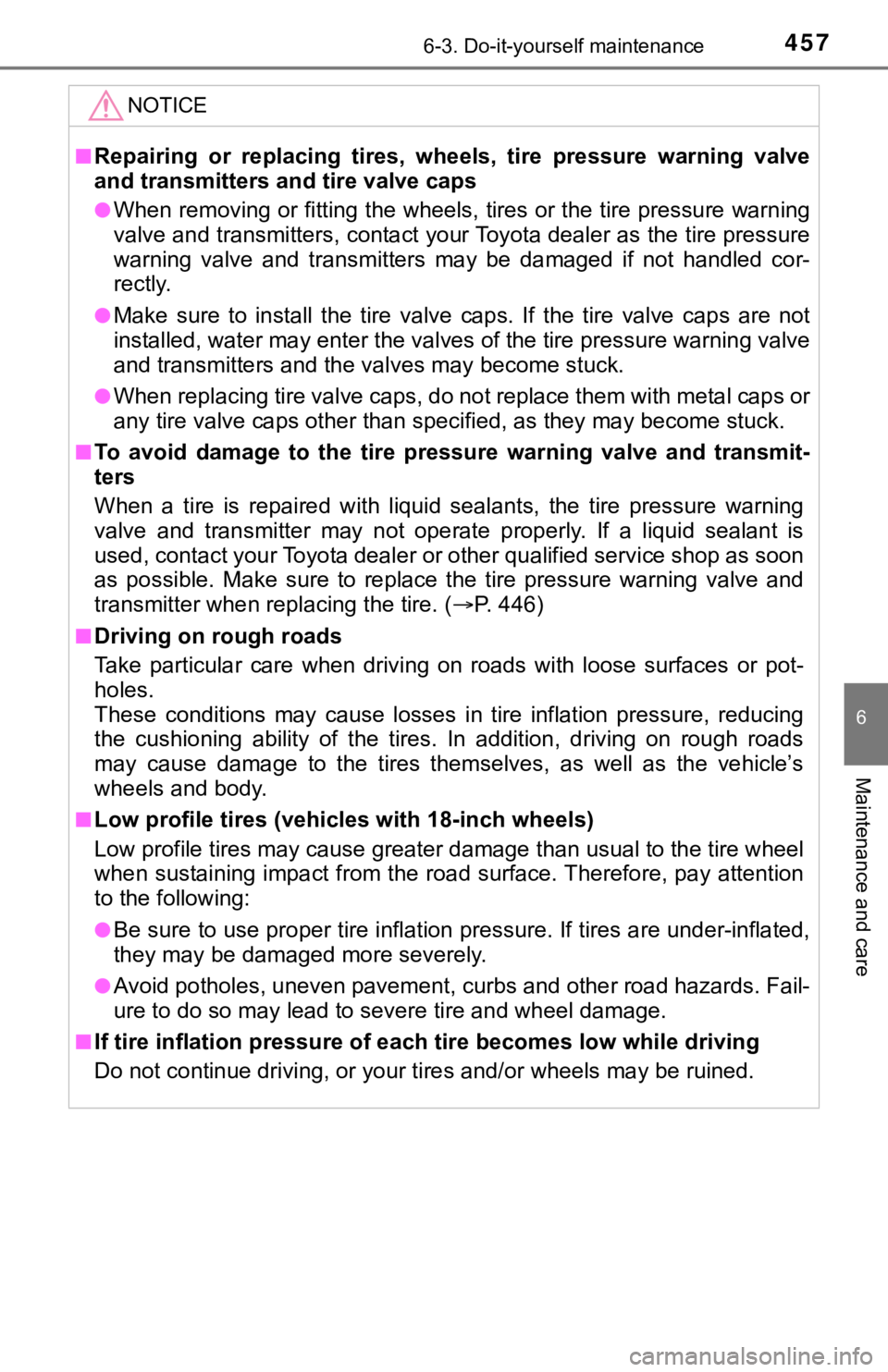
4576-3. Do-it-yourself maintenance
6
Maintenance and care
NOTICE
■Repairing or replacing tires, wheels, tire pressure warning valve
and transmitters and tire valve caps
●When removing or fitting the wheels, tires or the tire pressure warning
valve and transmitters, contact your Toyota dealer as the tire pressure
warning valve and transmitters may be damaged if not handled cor-
rectly.
●Make sure to install the tire valve caps. If the tire valve caps are not
installed, water may enter the valves of the tire pressure warning valve
and transmitters and the valves may become stuck.
●When replacing tire valve caps, do not replace them with metal caps or
any tire valve caps other than specified, as they may become stuck.
■To avoid damage to the tire pressure warning valve and transmit-
ters
When a tire is repaired with liquid sealants, the tire pressure warning
valve and transmitter may not operate properly. If a liquid sealant is
used, contact your Toyota dealer or other qualified service shop as soon
as possible. Make sure to replace the tire pressure warning valve and
transmitter when replacing the tire. (P. 4 4 6 )
■Driving on rough roads
Take particular care when driving on roads with loose surfaces or pot-
holes.
These conditions may cause losses in tire inflation pressure, reducing
the cushioning ability of the tires. In addition, driving on rough roads
may cause damage to the tires themselves, as well as the vehicle’s
wheels and body.
■Low profile tires (vehicles with 18-inch wheels)
Low profile tires may cause greater damage than usual to the tire wheel
when sustaining impact from the road surface. Therefore, pay attention
to the following:
●Be sure to use proper tire inflation pressure. If tires are under-inflated,
they may be damaged more severely.
●Avoid potholes, uneven pavement, curbs and other road hazards. Fail-
ure to do so may lead to severe tire and wheel damage.
■If tire inflation pressure of each tire becomes low while driving
Do not continue driving, or your tires and/or wheels may be ruined.
Page 460 of 624
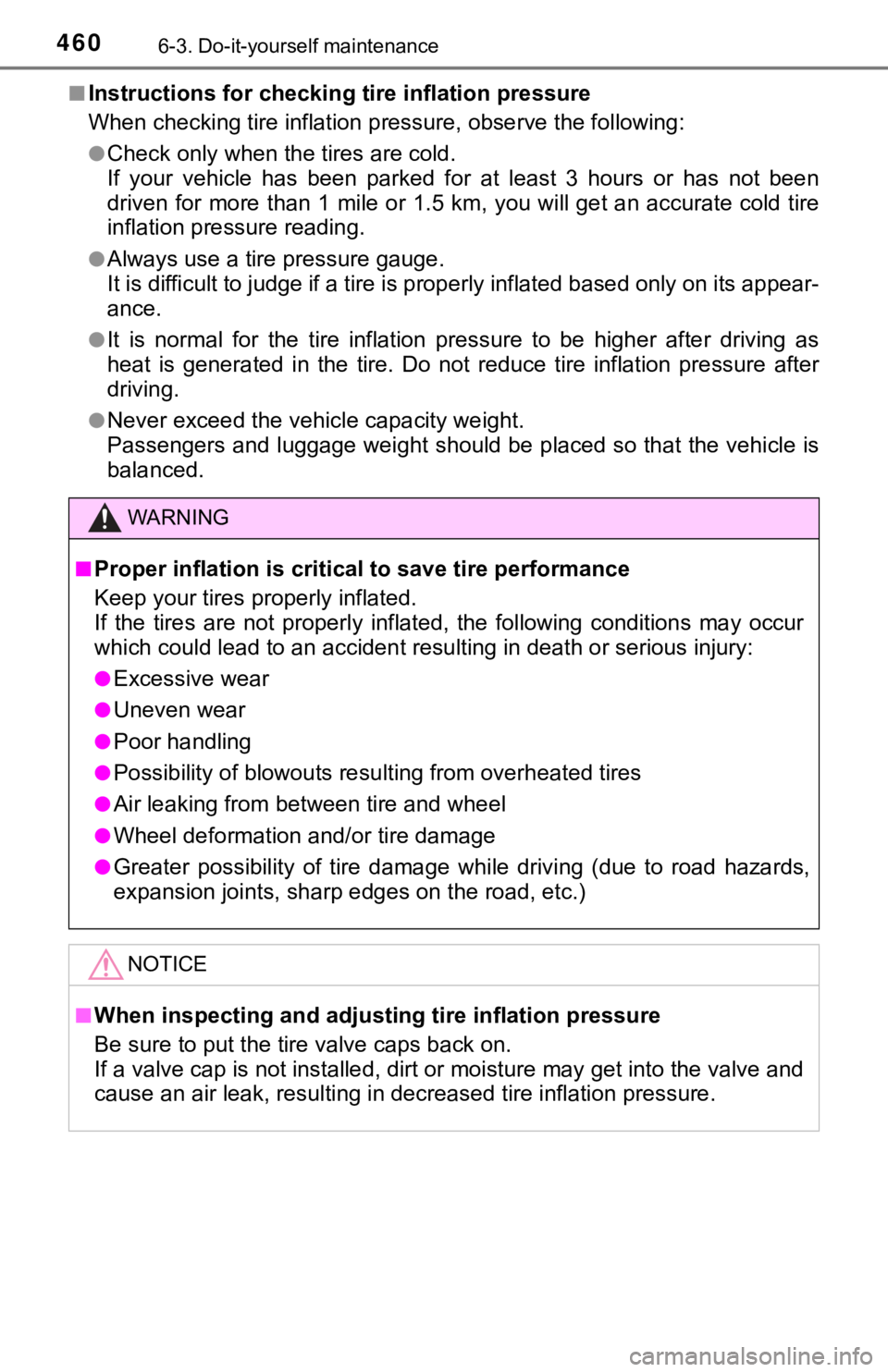
4606-3. Do-it-yourself maintenance
■Instructions for checking tire inflation pressure
When checking tire inflation pressure, observe the following:
●Check only when the tires are cold.
If your vehicle has been parked for at least 3 hours or has not been
driven for more than 1 mile or 1.5 km, you will get an accurate cold tire
inflation pressure reading.
●Always use a tire pressure gauge.
It is difficult to judge if a tire is properly inflated based only on its appear-
ance.
●It is normal for the tire inflation pressure to be higher after driving as
heat is generated in the tire. Do not reduce tire inflation pressure after
driving.
●Never exceed the vehicle capacity weight.
Passengers and luggage weight should be placed so that the vehicle is
balanced.
WARNING
■Proper inflation is critical to save tire performance
Keep your tires properly inflated.
If the tires are not properly inflated, the following conditions may occur
which could lead to an accident resulting in death or serious injury:
●Excessive wear
●Uneven wear
●Poor handling
●Possibility of blowouts resulting from overheated tires
●Air leaking from between tire and wheel
●Wheel deformation and/or tire damage
●Greater possibility of tire damage while driving (due to road hazards,
expansion joints, sharp edges on the road, etc.)
NOTICE
■When inspecting and adjusting tire inflation pressure
Be sure to put the tire valve caps back on.
If a valve cap is not installed, dirt or moisture may get into the valve and
cause an air leak, resulting in decreased tire inflation pressure.
Page 461 of 624
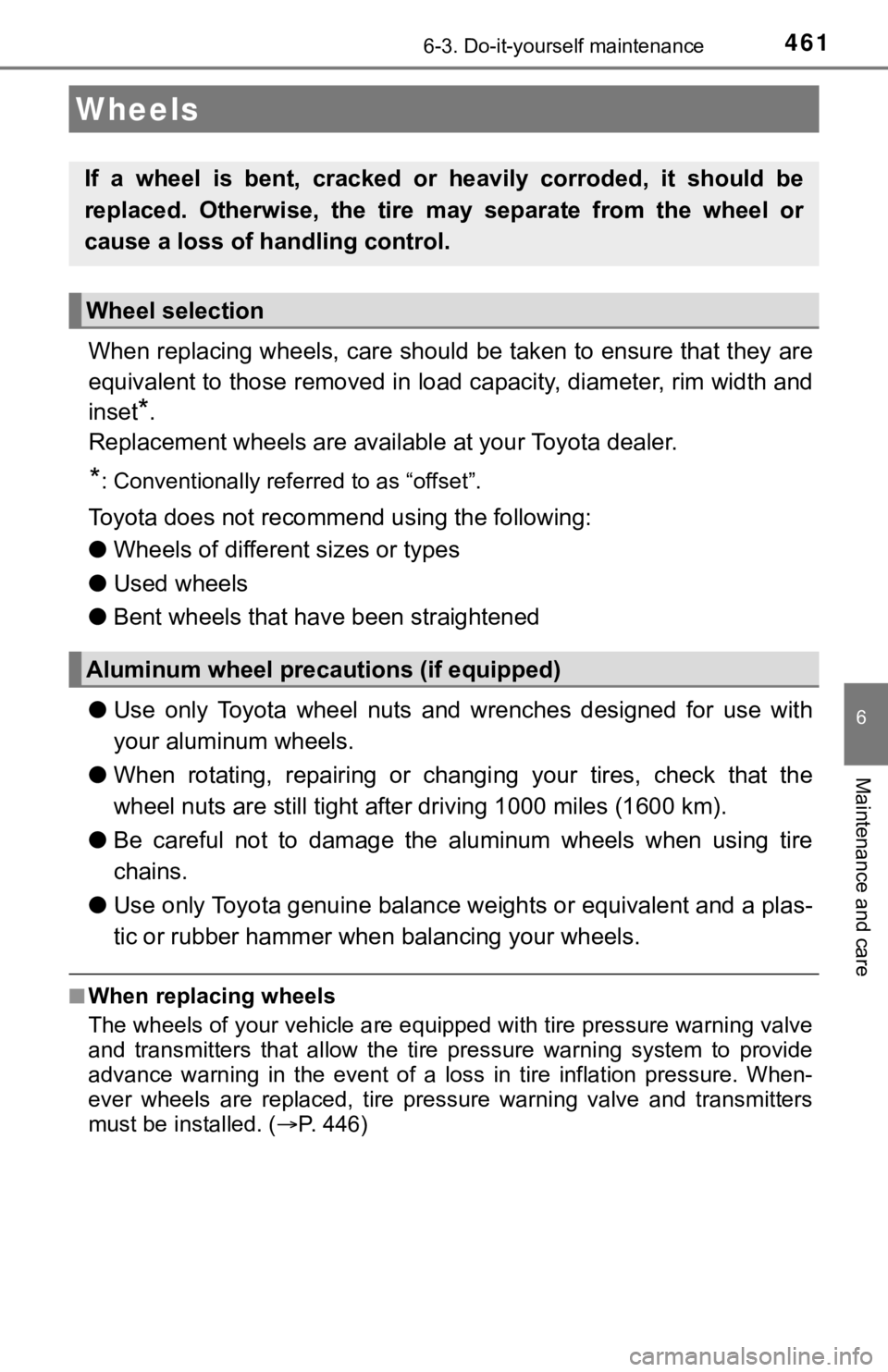
4616-3. Do-it-yourself maintenance
6
Maintenance and care
When replacing wheels, care should be taken to ensure that they are
equivalent to those removed in load capacity, diameter, rim width and
inset
*.
Replacement wheels are available at your Toyota dealer.
*: Conventionally referred to as “offset”.
Toyota does not recommend using the following:
●Wheels of different sizes or types
●Used wheels
●Bent wheels that have been straightened
●Use only Toyota wheel nuts and wrenches designed for use with
your aluminum wheels.
●When rotating, repairing or changing your tires, check that the
wheel nuts are still tight after driving 1000 miles (1600 km).
●Be careful not to damage the aluminum wheels when using tire
chains.
●Use only Toyota genuine balance weights or equivalent and a plas-
tic or rubber hammer when balancing your wheels.
■When replacing wheels
The wheels of your vehicle are equipped with tire pressure warning valve
and transmitters that allow the tire pressure warning system to provide
advance warning in the event of a loss in tire inflation pressure. When-
ever wheels are replaced, tire pressure warning valve and transmitters
must be installed. (P. 446)
Wheels
If a wheel is bent, cracked or heavily corroded, it should be
replaced. Otherwise, the tire may separate from the wheel or
cause a loss of handling control.
Wheel selection
Aluminum wheel precautions (if equipped)
Page 462 of 624
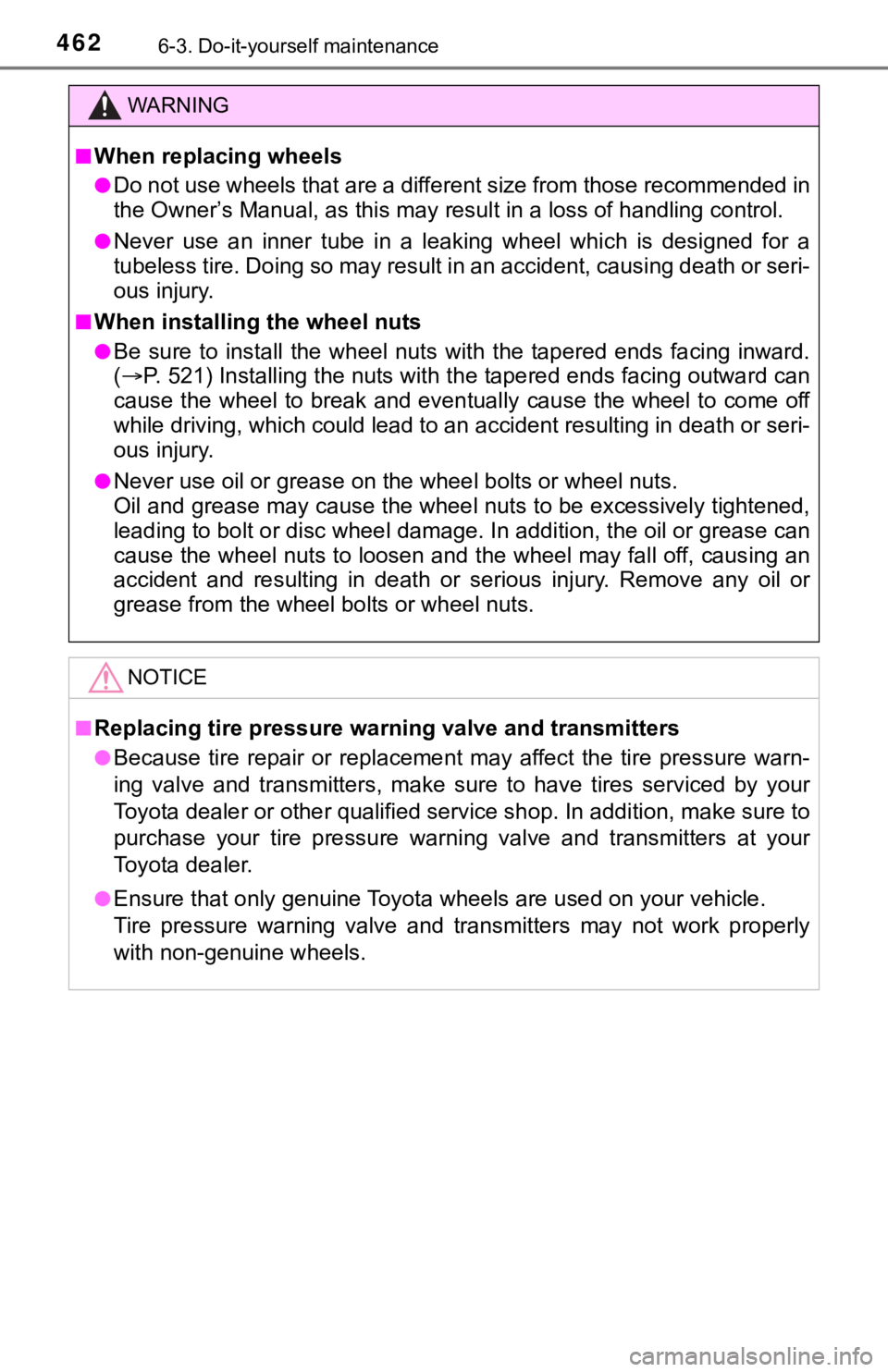
4626-3. Do-it-yourself maintenance
WARNING
■When replacing wheels
●Do not use wheels that are a different size from those recommended in
the Owner’s Manual, as this may result in a loss of handling control.
●Never use an inner tube in a leaking wheel which is designed for a
tubeless tire. Doing so may result in an accident, causing death or seri-
ous injury.
■When installing the wheel nuts
●Be sure to install the wheel nuts with the tapered ends facing inward.
(P. 521) Installing the nuts with the tapered ends facing outward can
cause the wheel to break and eventually cause the wheel to come off
while driving, which could lead to an accident resulting in death or seri-
ous injury.
●Never use oil or grease on the wheel bolts or wheel nuts.
Oil and grease may cause the wheel nuts to be excessively tightened,
leading to bolt or disc wheel damage. In addition, the oil or grease can
cause the wheel nuts to loosen and the wheel may fall off, causing an
accident and resulting in death or serious injury. Remove any oil or
grease from the wheel bolts or wheel nuts.
NOTICE
■Replacing tire pressure warning valve and transmitters
●Because tire repair or replacement may affect the tire pressure warn-
ing valve and transmitters, make sure to have tires serviced by your
Toyota dealer or other qualified service shop. In addition, make sure to
purchase your tire pressure warning valve and transmitters at your
Toyota dealer.
●Ensure that only genuine Toyota wheels are used on your vehicle.
Tire pressure warning valve and transmitters may not work properly
with non-genuine wheels.
Page 468 of 624

4686-3. Do-it-yourself maintenance
■Scheduled maintenance of the air intake vent is necessary when
In some situations such as when the vehicle is used frequently or in heavy
traffic or dusty areas, the air intake vent may need to be cleaned more regu-
larly. For details, refer to “Scheduled Maintenance Guide” or “Owner’s Man-
ual Supplement”.
■Cleaning the air intake vent
●Dust in the air intake vent may interfere with the cooling of the hybrid battery
(traction battery). If charging/discharging of the hybrid battery (traction bat-
tery) becomes limited, the distance that the vehicle can be driven using the
electric motor (traction motor) may be reduced and the fuel economy may
be reduced.
Inspect and clean the air intake vent periodically.
●Improper handling of the air intake vent cover and filter may result in dam-
age to them. If you have any concerns about cleaning the filter, contact your
Toyota dealer.
■If “Maintenance Required for Traction Battery Cooling Parts See Owner’s
Manual” is displayed on the multi-information display
●If this warning message is displayed on the multi-information display,
remove the air intake vent cover and clean the filter. (P. 465)
●After cleaning the air intake vent, start the hybrid system and check that the
warning message is no longer displayed.
After the hybrid system is started, it may be necessary to drive the vehicle
up to approximately 20 minutes before the warning message disappears. If
the warning message does not disappear after driving for appropriately 20
minutes, have the vehicle inspected by your Toyota dealer.
WARNING
■When cleaning the air intake vent
●Do not use water or other liquids to clean the air intake vent. If water is
applied to the hybrid battery (traction battery) or other components, a mal-
function or fire may occur.
●Before cleaning the air intake vent, make sure to turn the power switch off
to stop the hybrid system.
■
When removing the air intake vent cover
Do not touch the service plug located near the air intake vent. (P. 85)
Page 469 of 624
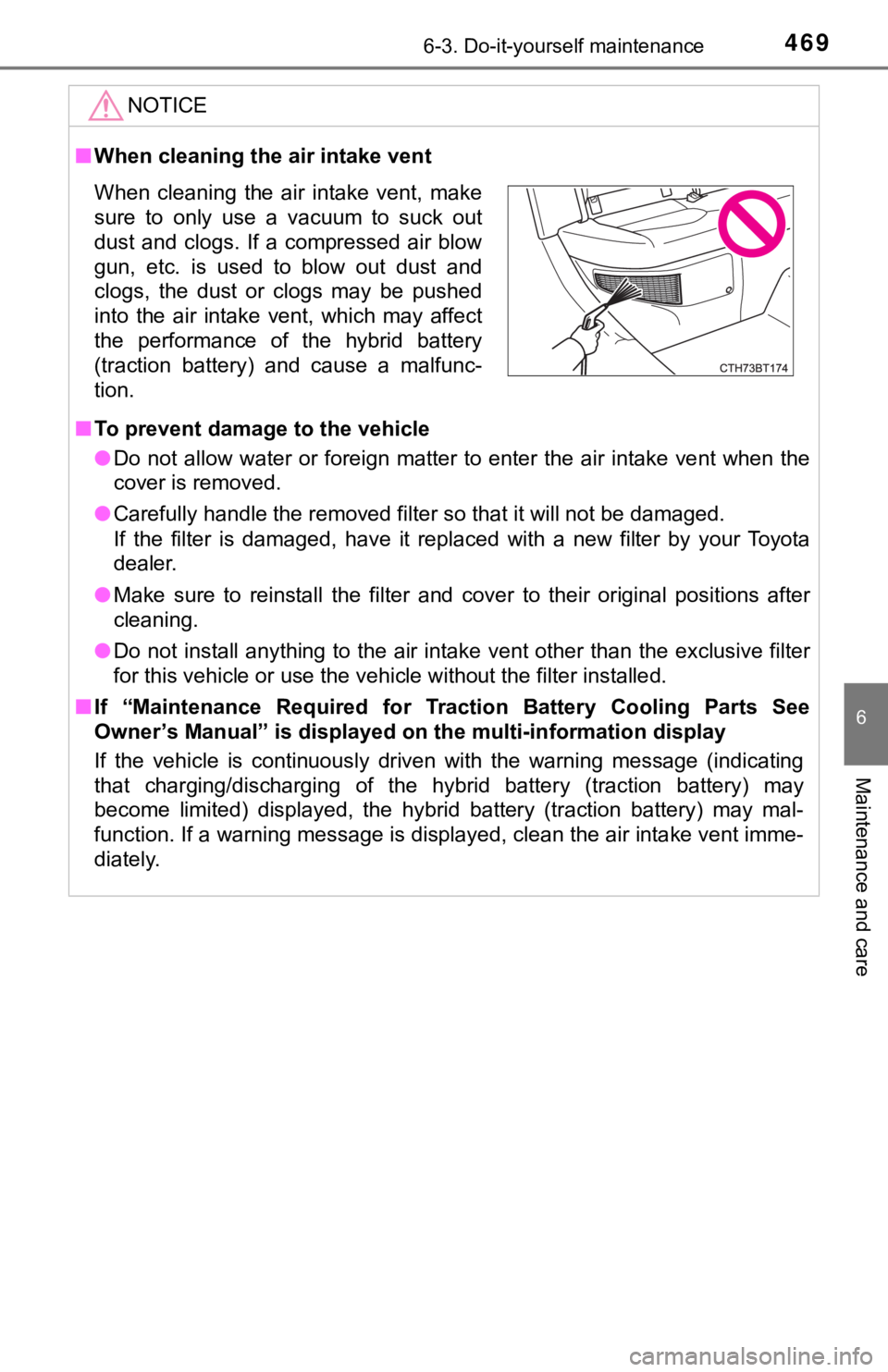
4696-3. Do-it-yourself maintenance
6
Maintenance and care
NOTICE
■When cleaning the air intake vent
■To prevent damage to the vehicle
●Do not allow water or foreign matter to enter the air intake vent when the
cover is removed.
●Carefully handle the removed filter so that it will not be damaged.
If the filter is damaged, have it replaced with a new filter by your Toyota
dealer.
●Make sure to reinstall the filter and cover to their original positions after
cleaning.
●Do not install anything to the air intake vent other than the exclusive filter
<00490052005500030057004b004c0056000300590048004b004c0046004f0048000300520055000300580056004800030057004b0048000300590048004b004c0046004f00480003005a004c0057004b00520058005700030057004b004800030049004c00
4f0057004800550003004c0051005600570044004f004f0048[d.
■If “Maintenance Required for Traction Battery Cooling Parts See
Owner’s Manual” is displayed on the multi-information display
If the vehicle is continuously driven with the warning message (indicating
that charging/discharging of the hybrid battery (traction battery) may
become limited) displayed, the hybrid battery (traction battery) may mal-
function. If a warning message is displayed, clean the air intake vent imme-
diately.
When cleaning the air intake vent, make
sure to only use a vacuum to suck out
dust and clogs. If a compressed air blow
gun, etc. is used to blow out dust and
clogs, the dust or clogs may be pushed
into the air intake vent, which may affect
the performance of the hybrid battery
(traction battery) and cause a malfunc-
tion.
Page 471 of 624
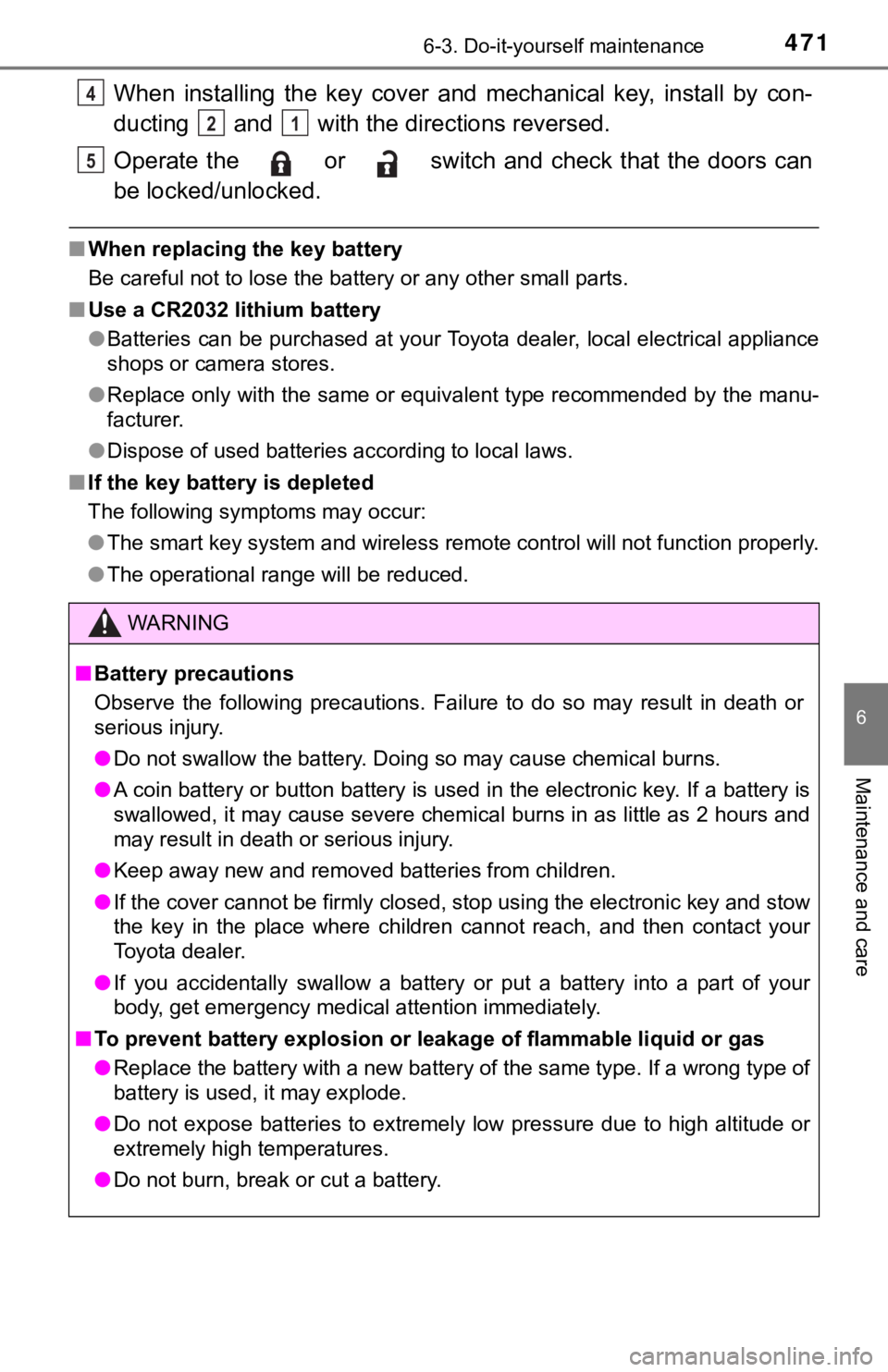
4716-3. Do-it-yourself maintenance
6
Maintenance and care
When installing the key cover and mechanical key, install by con-
ducting and with the directions reversed.
Operate the or switch and check that the doors can
be locked/unlocked.
■When replacing the key battery
<002500480003004600440055004800490058004f00030051005200570003005700520003004f00520056004800030057004b00480003004500440057005700480055005c000300520055000300440051005c000300520057004b0048005500030056005000
44004f004f0003005300440055005700560011[
■Use a CR2032 lithium battery
●Batteries can be purchased at your Toyota dealer, local electrical appliance
shops or camera stores.
●Replace only with the same or equivalent type recommended by the manu-
facturer.
●Dispose of used batteries according to local laws.
■If the key battery is depleted
The following symptoms may occur:
●The smart key system and wireless remote control will not function properly.
●The operational range will be reduced.
WARNING
■Battery precautions
Observe the following precautions. Failure to do so may result in death or
serious injury.
●Do not swallow the battery. Doing so may cause chemical burns.
●A coin battery or button battery is used in the electronic key. If a battery is
swallowed, it may cause severe chemical burns in as little as 2 hours and
may result in death or serious injury.
●Keep away new and removed batteries from children.
●If the cover cannot be firmly closed, stop using the electronic key and stow
the key in the place where children cannot reach, and then contact your
Toyota dealer.
●If you accidentally swallow a battery or put a battery into a part of your
body, get emergency medical attention immediately.
■To prevent battery explosion or leakage of flammable liquid or gas
●Replace the battery with a new battery of the same type. If a wrong type of
battery is used, it may explode.
●Do not expose batteries to extremely low pressure due to high altitude or
extremely high temperatures.
●Do not burn, break or cut a battery.
4
21
5
Page 475 of 624
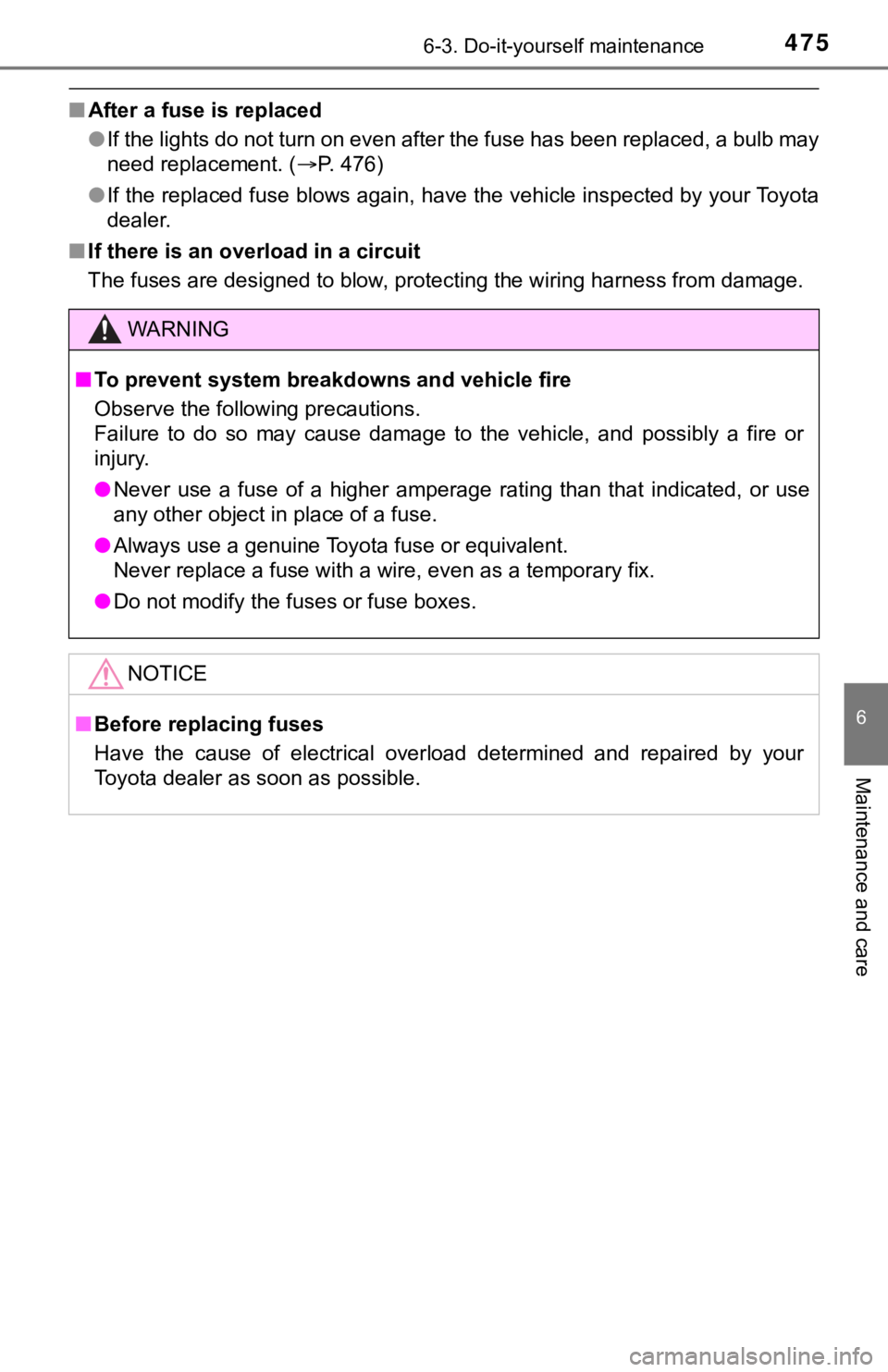
4756-3. Do-it-yourself maintenance
6
Maintenance and care
■After a fuse is replaced
●If the lights do not turn on even after the fuse has been replaced, a bulb may
need replacement. (P. 476)
●If the replaced fuse blows again, have the vehicle inspected by your Toyota
dealer.
■If there is an overload in a circuit
The fuses are designed to blow, protecting the wiring harness from damage.
WARNING
■To prevent system breakdowns and vehicle fire
Observe the following precautions.
Failure to do so may cause damage to the vehicle, and possibly a fire or
injury.
●Never use a fuse of a higher amperage rating than that indicated, or use
any other object in place of a fuse.
●Always use a genuine Toyota fuse or equivalent.
Never replace a fuse with a wire, even as a temporary fix.
●Do not modify the fuses or fuse boxes.
NOTICE
■Before replacing fuses
Have the cause of electrical overload determined and repaired by your
Toyota dealer as soon as possible.
Page 487 of 624

4876-3. Do-it-yourself maintenance
6
Maintenance and care
WARNING
■Replacing light bulbs
●Turn off the lights. Do not attempt to replace the bulb immediately after
turning off the lights.
The bulbs become very hot and may cause burns.
●Do not touch the glass portion of the light bulb with bare hands. When it is
unavoidable to hold the glass portion, use and hold with a clean dry cloth
to avoid getting moisture and oils on the bulb.
Also, if the bulb is scratched or dropped, it may blow out or crack.
●Fully install light bulbs and any parts used to secure them. Failure to do so
may result in heat damage, fire, or water entering the headlight unit. This
may damage the headlights or cause condensation to build up on the lens.
■To prevent damage or fire
Make sure bulbs are fully seated and locked.
Page 489 of 624

489
7When trouble arises
7-1. Essential information
Emergency flashers .......... 490
If your vehicle has
to be stopped in
an emergency ................. 491
If the vehicle is submerged
or water on the road is
rising ............................... 492
7-2. Steps to take in
an emergency
If your vehicle needs
to be towed ..................... 493
If you think something
is wrong .......................... 496
If a warning light turns
on or a warning
buzzer sounds ................ 497
If a warning message
is displayed ..................... 507
If you have a flat tire.......... 513
If the hybrid system will
not start ........................... 525
If the electronic key
does not operate
properly ........................... 527
If the 12-volt battery
is discharged ................... 530
If your vehicle
overheats ........................ 537
If the vehicle becomes
stuck ............................... 541